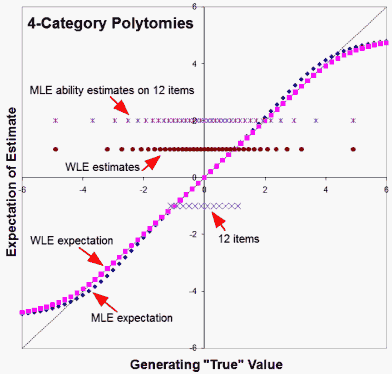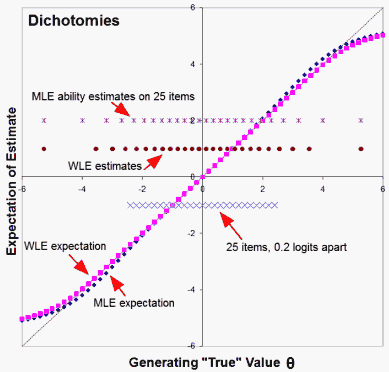Warm's bias correction is applied to each MLE estimate, M(s), to produce a Warm's Mean Likelihood Estimation (WLE) value, W(s).
See Figure 1. WLE estimates are more central than the MLE estimates, except for estimates corresponding to scores of 0.3 and 24.7, where the MLE estimates are used unchanged.
Under Rasch model conditions, each raw score, s, on a given set of items, corresponds to one estimated ability θ(s), but each true (generating) ability corresponds to all possible raw scores. For 25 items, there are 2^25 = 33,554,432 possible different response strings. According to the Rasch model, each of these response strings has a finite probability of being observed for each generating ability.
Probability of response string n for ability θ
= Pnθ = Π exp( (xni (θ - di) ) / (1 + exp(θ - di) )
for i = 1 to 25, where xni is the scored 0,1 response to item i in response string n, and di is the difficulty of item i.
Response string n has a raw score of s = Σ xni for i = 1 to 25. Score s has an MLE estimate of Mn = M(s) and a WLE estimate of Wn = W(s).
The expected values of the estimates corresponding to each generating value can now be computed:
Expectation (MLE(θ)) = Σ Pnθ Mn for n = 1 to 2^25
Expectation (WLE(θ)) = Σ Pnθ Wn for n = 1 to 2^25
These values are plotted in Figure 1 for θ in the range -6 logits to +6 logits. The WLE ogive corresponds to the identity line with the generating values for most of its range.
The MLE ogive is slightly less central (as predicted by Fred Lord). We can see that the WLE bias correction is effective over the entire range of MLE estimates for non-extreme scores (-4 to +4 logits).
The biggest bias correction is 0.23 logits at a generating value of 3.6 logits, as shown in Figure 2.
This is less than half the size of the standard error of each estimate which is close to 0.5 logits for most of the range. We can also see that, for "true" generating abilities within 2 logits of the center of the test, the MLE bias is less than 0.1 logits, and so negligible for practical purposes.

Figure 2. Detail of Figure 1 showing MLE bias.
|
Similar investigations for tests of length 2 to 24 items demonstrated that the WLE bias correction is effective for tests of 7 dichotomous items or more.
Polytomous Items
We can apply the same logic to Rasch-model polytomous items.
Bias (θMLE) = - J / ( 2 * I2 )
J = = Σ Σ (P'θikP"θik)/Pθik
= Σ( (Σk³Pθik ) - 3(Σk²Pθik )(ΣkPθik ) + 2(ΣkPθik )³ )
I = Σ( (Σk²Pθik ) - (ΣkPθik )² )
where Pθik is the Rasch-model probability of a person of ability θ being observed in category k of item i,
and the summations are over i=1, L and the polytomous categories k=0,m.
The corrected estimate, θWLE = θMLE + (J / ( 2 * I2 ) ), which is almost always
closer to the item mean than θMLE.
The results of this investigation are shown in Figure 3 with items 0.1 logits apart, and thresholds 1 logit apart. Using the estimation procedure in Linacre (1998), the results are similar to the findings for dichotomous items in Figure 1.
Warm's bias correction is seen to be efficacious for the correction of MLE bias across the useful measurement range of
the items, but MLE bias is also seen to be inconsequential for most practical purposes.

Figure 3. MLE and WLE for 12, 4-category, items.
|
John M. Linacre
Linacre J.M. (1998) Estimating Rasch measures with known polytomous (or rating scale) item difficulties: Anchored Maximum Likelihood Estimation (AMLE), RMT 12:2 p. 638
Lord, F. M. (1983). Unbiased estimators of ability parameters, of their variance, and of their parallel-forms reliability. Psychometrika, 48, 2, 233-245.
Warm T.A. (1989) Weighted Likelihood Estimation of Ability in Item Response Theory. Psychometrika, 54, 427-450.
Wright B.D., Douglas G.A. (1996) Estimating measures with known dichotomous item difficulties. Rasch Measurement Transactions, 10:2, 499
Linacre J.M. (2009) The Efficacy of Warm's Weighted Mean Likelihood Estimate (WLE) Correction to Maximum Likelihood Estimate (MLE) Bias, Rasch Measurement Transactions, 2009, 23:1, 1188-9
| Rasch Books and Publications |
|---|
| Invariant Measurement: Using Rasch Models in the Social, Behavioral, and Health Sciences, 2nd Edn. George Engelhard, Jr. & Jue Wang |
Applying the Rasch Model (Winsteps, Facets) 4th Ed., Bond, Yan, Heene |
Advances in Rasch Analyses in the Human Sciences (Winsteps, Facets) 1st Ed., Boone, Staver |
Advances in Applications of Rasch Measurement in Science Education, X. Liu & W. J. Boone |
Rasch Analysis in the Human Sciences (Winsteps) Boone, Staver, Yale |
| Introduction to Many-Facet Rasch Measurement (Facets), Thomas Eckes |
Statistical Analyses for Language Testers (Facets), Rita Green |
Invariant Measurement with Raters and Rating Scales: Rasch Models for Rater-Mediated Assessments (Facets), George Engelhard, Jr. & Stefanie Wind |
Aplicação do Modelo de Rasch (Português), de Bond, Trevor G., Fox, Christine M |
Appliquer le modèle de Rasch: Défis et pistes de solution (Winsteps) E. Dionne, S. Béland |
| Exploring Rating Scale Functioning for Survey Research (R, Facets), Stefanie Wind |
Rasch Measurement: Applications, Khine |
Winsteps Tutorials - free
Facets Tutorials - free |
Many-Facet Rasch Measurement (Facets) - free, J.M. Linacre |
Fairness, Justice and Language Assessment (Winsteps, Facets), McNamara, Knoch, Fan |
| Other Rasch-Related Resources: Rasch Measurement YouTube Channel |
|---|
Rasch Measurement Transactions &
Rasch Measurement research papers - free |
An Introduction to the Rasch Model with Examples in R (eRm, etc.), Debelak, Strobl, Zeigenfuse |
Rasch Measurement Theory Analysis in R, Wind, Hua |
Applying the Rasch Model in Social Sciences Using R, Lamprianou |
El modelo métrico de Rasch:
Fundamentación, implementación e interpretación de la medida en ciencias sociales (Spanish Edition),
Manuel González-Montesinos M. |
| Rasch Models: Foundations, Recent Developments, and Applications, Fischer & Molenaar |
Probabilistic Models for Some Intelligence and Attainment Tests, Georg Rasch |
Rasch Models for Measurement, David Andrich |
Constructing Measures, Mark Wilson |
Best Test Design - free, Wright & Stone
Rating Scale Analysis - free, Wright & Masters |
| Virtual Standard Setting: Setting Cut Scores, Charalambos Kollias |
Diseño de Mejores Pruebas - free, Spanish Best Test Design |
A Course in Rasch Measurement Theory, Andrich, Marais |
Rasch Models in Health, Christensen, Kreiner, Mesba |
Multivariate and Mixture Distribution Rasch Models, von Davier, Carstensen |
Go to Top of Page
Go to index of all Rasch Measurement Transactions
AERA members: Join the Rasch Measurement SIG and receive the printed version of RMT
Some back issues of RMT are available as bound volumes
Subscribe to Journal of Applied Measurement
Go to Institute for Objective Measurement Home Page.
The Rasch Measurement SIG (AERA) thanks the Institute for Objective Measurement for inviting the publication of Rasch Measurement Transactions on the Institute's website, www.rasch.org.
| Coming Rasch-related Events |
|---|
| Jan. 16 - Feb. 13, 2025, Fri.-Fri. | On-line workshop: Rasch Measurement - Core Topics (E. Smith, Winsteps), www.statistics.com |
| Apr. 8 - Apr. 11, 2026, Wed.-Sat. | National Council for Measurement in Education - Los Angeles, CA, ncme.org/events/2026-annual-meeting |
| Apr. 8 - Apr. 12, 2026, Wed.-Sun. | American Educational Research Association - Los Angeles, CA, www.aera.net/AERA2026 |
| May. 15 - June 12, 2026, Fri.-Fri. | On-line workshop: Rasch Measurement - Core Topics (E. Smith, Winsteps), www.statistics.com |
| June 19 - July 25, 2026, Fri.-Sat. | On-line workshop: Rasch Measurement - Further Topics (E. Smith, Winsteps), www.statistics.com |
The URL of this page is
www.rasch.org/rmt/rmt231d.htm
Website: www.rasch.org/rmt/contents.htm


